What does a hawthorn look like and how to plant it?

Hawthorn has a lot of useful properties, so it is often grown in summer cottages. In addition, it is also used as an ornamental plant. Today we will talk about what a hawthorn looks like, how to plant it correctly, and how to care for it.
Description
Hawthorn looks like a tree-like shrub or a small tree (belongs to the pink family). The plant is widely used for the preparation of various medicinal compositions, for decorating landscape design. Its fruits can be eaten.
The crown of the tree is dense and round. It can also be ovoid in shape. Sometimes it is asymmetrical. The bark of the plant is brown or gray; a large number of cracks of various sizes can be observed on it. The bark may be ribbed.


Hawthorn branches are straight or weeping, sometimes branches in the form of zigzags are found. Young shoots grow slightly pubescent or completely naked. Their colors are bright purple. On trees you can see leafless thorns up to 10 mm long. They develop from the axillary buds. Hawthorn leaves can have various shapes, including round, elliptical, ovoid. The edges can be split or jagged. The length of the leaf blades ranges from 1 to 10 cm. The foliage surface can be bare or densely pubescent.
In the fall season, the leaves take on an orange or purple color. But some varieties are able to retain their green color until late autumn. Hawthorn flowers can be white, pink or red. Their diameter reaches 1-2 cm. Each bud has five petals. Flowers are collected in corymbose or umbrella-shaped inflorescences. Hawthorn bloom begins in spring or early summer. During this period, the entire tree is covered with a huge number of small flowers.
The fruits of the culture are small apples, their shape is spherical or pear-shaped. Their size varies greatly (from 4 mm to 4 cm). Inside the fruit, several seeds are singing. The color of the fruit will depend on the variety, type of hawthorn. Most often they are red, orange, yellow, and almost black specimens are also found. The berries ripen in September-October.
Hawthorn is actively cultivated in North America. In Russia, it is found in the West Siberian, East Siberian regions, in Transbaikalia.
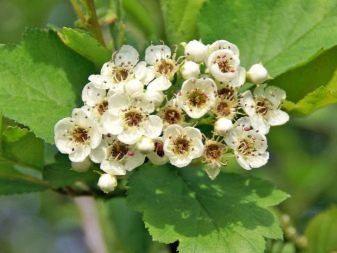

Views
Now we will consider the features of some individual species of hawthorn.
- Pear. This hawthorn grows with three-lobed leaves. It is grown in the western United States. The plant is a large tree 10-12 meters high. It is strewn with straight thorns, their length can be up to 5 centimeters. The buds of such a hawthorn gather in multi-flowered inflorescences. Fruits on the tree are bright red in color, their diameter is 6-8 mm. It is worth noting that this species is characterized by low winter hardiness, so it should not be grown in the middle lane.
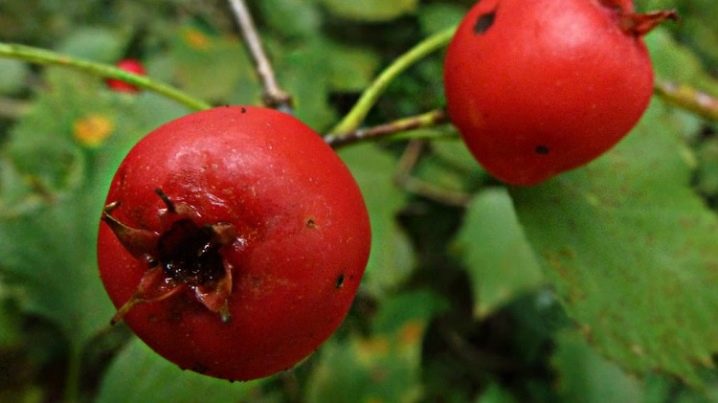
- Softish. It is sometimes also called semi-soft. The softish hawthorn is grown in North America. The height of a healthy adult tree reaches 7-8 meters. It has the most dense crown. The leaves of this species are dark green, their shape is ovoid. In young plants, they are densely pubescent, but with age, the pubescence disappears. Closer to autumn, the leaf blades acquire a brown hue.Large buds of such a hawthorn gather in corymbose inflorescences. Its berries are red-orange in color, their diameter can reach 2 cm. Their flesh is yellow.

- Periston cut. This species is also called Chinese. It is considered hardy and moisture-loving. The variety is absolutely undemanding to the soil. The plant is highly branched with a spreading lush crown. The height of an adult tree is 4-6 m. Its bark has a dark gray color. On it you can see a small number of thorns no more than 2 cm long. The leaves on the plants are bright green, the fruits are red spherical or pear-shaped. this species bears fruit quite abundantly.
The pinnate hawthorn has excellent decorative qualities.

- Shportsovy. This species is also called "cock spur". It is grown in the eastern United States. The height of an adult specimen ranges from 6 to 12 meters. The crown of the trees is broadly spreading, the branches drooping on it. The branches are densely covered with thorns 8-10 cm long. The foliage is whole, the length of the plates is 7-10 cm, they are leathery, bare, on their edges you can see uneven teeth. The leaves are colored dark green, but with the onset of autumn they turn orange. During flowering, a large number of small white buds up to 2 cm in diameter are formed on the hawthorn. This variety is considered drought-resistant, but its winter hardiness is low.
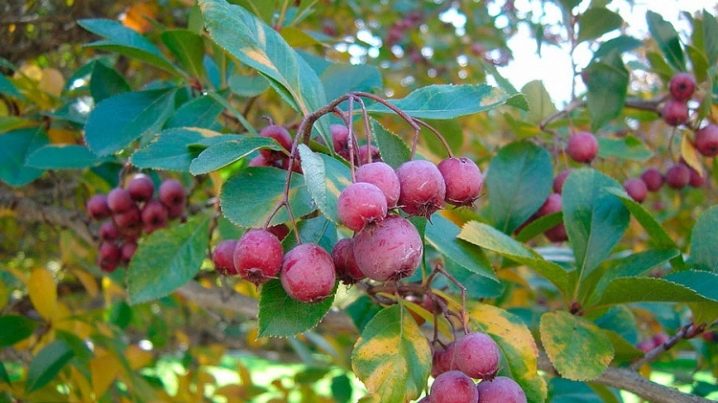
- Meat green. This species is grown in Japan, the Kuriles, Sakhalin and Kamchatka. It reaches a height of 3 to 6 m. The bark on the trees is gray. Young shoots are purple, they are covered with thorns up to 10-15 mm long. The foliage is ovoid, its upper part is pointed. Leaves can be either naked or pubescent. During flowering, a large number of white flowers form on the plants, they form shields. Hawthorn fruits are black with tasty green pulp.

- Monopest. This variety is found in the Caucasus, in Central Asia. It has the fastest growth. Plant height ranges from 3 to 6 meters. It has a symmetrical tent-shaped crown. Bare shoots on vegetation are densely covered with small spines up to 1 cm long. The leaves of this hawthorn can be ovoid or rhombic. During flowering, white or pink buds form on the tree. They gather in small inflorescences. One seed ripens in each fruit.

- Daursky. The species is a tree or shrub up to 5-6 m high. The crown of the plant is spreading with dark purple branches. There are thorns on their surface. Foliage can be either naked or pubescent. It is dark green in color. The shape of the leaves is ovoid or elongated rhombic. Flowers on this hawthorn are small, white, they are collected in corymbose inflorescences.

- Douglas hawthorn. This hawthorn grows in western North America. It has a high winter hardiness. The bark on the trunk is dark brown, lamellar. Branches are red-brown, can be weeping. The branches have curved or straight thorns. The leaves on the trees are elongated, ovoid or simply ovoid. Their top is pointed. The color of the foliage is dark green, with the onset of the autumn season, it turns yellow or orange.

Separately, it should be said about the blood-red hawthorn. This red-leaved ornamental specimen is known for its edible, beautiful fruits. They are widely used in the preparation of medicines. This species is also called Siberian hawthorn. The variety reaches a height of 5 meters. It is often used for landscaping parks, courtyards and squares.
Blood red hawthorn is resistant to air pollution and frost. It has a lush and beautiful spherical crown, purple shiny branches with hard thorns. The leaf plates are pubescent, their shape is diamond-shaped, there are small teeth at the edges. The flowers on the tree are white.They may have a slight pink tint. The buds are collected in inflorescences.

Landing
Let's figure out how to plant a hawthorn correctly. The easiest way is to purchase ready-made seedlings in the nursery. Sometimes gardeners buy seeds for growing seedlings. You can plant a plant in open ground in early spring or autumn. The area to be planted should be well lit by sunlight. Remember that the hawthorn prefers fertile land.
If you will plant several trees, then you need to maintain a distance of at least 2 meters between them. Planting holes should be prepared in advance. A mixture consisting of soil, peat and sand is poured into them. Lime and organic matter are also added there. Plants that are at least two years old are suitable for planting. Immediately before planting, a drainage from rubble and broken brick is formed at the bottom of each pit. Sand is poured on top (layer thickness 5-7 cm).
Further, the young bush is neatly placed in the hole. After that, it is covered with soil mixture. In the process of work, handle the roots as carefully as possible so as not to damage them. Immediately after planting, the culture is well watered. It is recommended to mulch the near-trunk zone with compost or humus. The layer thickness must be at least 5 centimeters.
Then the plant must be cut, while leaving stems 10-12 cm long.

Care
To grow a strong and healthy hawthorn, you need to properly care for it.
Watering and feeding
This crop is watered once during the normal season. At the same time, one adult tree has a full bucket of water. The amount of watering is increased during dry periods. In addition, the hawthorn also needs additional feeding. Fertilizer is recommended to be applied in the spring before flowering. In this case, it is better to use slurry (one plant has one full bucket of such organic matter). To prepare it, 1 liter of manure is stirred in 10 liters of water.
Pruning
If the place for planting the plant was initially selected correctly, then it independently forms a beautiful and correct crown, acquires a decorative appearance. Still, sanitary pruning doesn't hurt at all. Most often, such procedures are performed in the spring. In the process of pruning, damaged and dried shoots are removed. If you are growing a varietal hawthorn for picking berries, then the procedure must be carried out inside the crown, this will prevent excessive thickening.
The formation of the crown of decorative species is carried out regularly. Shrubs and trees can easily tolerate this procedure. But to give them various forms, pruning not only shoots, but also leaves is required. And they do it several times a season.

Reproduction
The planting material of such a culture is obtained by layering, root cuttings, seeds, grafting on a stem. On personal plots, a simple method with layering is most often used. In this case, perform the following actions.
- In early spring, holes are digged near the mother plant with a depth of no more than 10 cm.
- At the same time, the soil is prepared for the planting sites. The lower branches of the bushes are placed in the grooves made, while the apical buds remain on the surface.
- In order for the flexible branches not to interfere, it is better to fix them with brackets and cover them with earth, after which everything is well watered and mulched.
- Throughout the season, 4-5 waterings are performed. After the formation of young shoots, their bases are covered with soil mounds with a height of 10-15 cm.
- In the fall or next spring, the plants are planted so that they can grow.
Remember that if the root systems are damaged, shoots will begin to form in mature plants. It is considered a suitable planting material. After the young bushes form their root system, they are seated in prepared places.


Diseases and pests
Hawthorn can be infected with the following infections.
- Powdery mildew. With such a disease, spots of gray and white flowers form on the foliage and stems of the bush, they can have different sizes. Over time, these areas begin to deform and die off. In case of infection, damaged areas should be removed immediately. After that, the hawthorn is treated with chemicals (for example, "Vectra").
- Brown spot. This disease causes round brown spots to appear on the outer surface of the leaves. Dying off occurs in these areas.
- Gray spotting. When a bush is infected with gray spots, the foliage will be covered with a large number of gray spots.
- Yellow spot. In this case, the leaf blades will be covered with large yellow spots. Over time, they turn brown. Further, diseased leaves fall off.
To cure vegetation from these diseases, you should use drugs that contain copper (Bordeaux liquid). Sometimes such formulations are used for prophylactic purposes. Hawthorn can also be affected by pests.
- Leaf roll. The parasite lays its eggs on the bark. Grown caterpillars gnaw buds and ovaries, and then move on to young leaves. To destroy the leaf roll, you can use the drug "Chlorophos".
- Hawthorn. This butterfly lays eggs on foliage. Small caterpillars eat buds and young leaves.
- Apple scale insect. It is a small insect that actively sucks sap from plants. To get rid of the scale insect, they are treated with strong insecticides.
- Aphid. The parasite most often appears on young plants. He feeds on the sap of the tree. As a result, the leaves on the bushes and trees curl and wither. The branches begin to dry out and die. To destroy aphids, ready-made chemicals are used. The best option would be the composition of "Karbofos". It is dissolved in water, and then sprayed with it. To combat aphids, a simple soap solution, infusion with tobacco and garlic is also used.
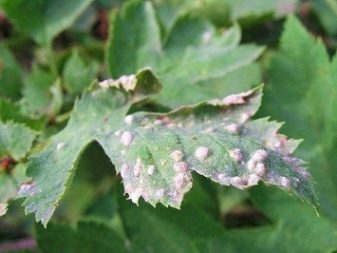
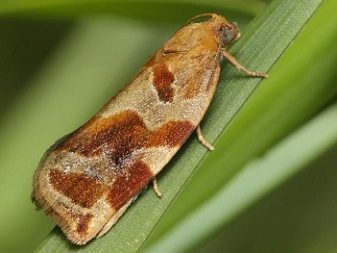
Application in landscape design
- Often, whole hedges are formed from tall hawthorn trees on the site. They become a real reliable fence. Plants can be left in their natural form, or you can give them a square, conical or round shape with a garden tool.

- In landscape design in the country, one large and tall tree looks good, blooming with red flowers and bright fruits. This plant can become a real beautiful accent in the overall design. It is better to plant it next to simple green spaces.




































































The comment was sent successfully.